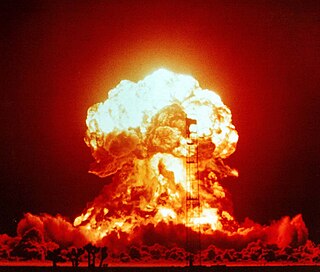 W
WThis is a list of books about nuclear issues. They are non-fiction books which relate to uranium mining, nuclear weapons and/or nuclear power.American Prometheus: The Triumph and Tragedy of J. Robert Oppenheimer (2005) The Angry Genie: One Man's Walk Through the Nuclear Age (1999) The Atom Besieged: Extraparliamentary Dissent in France and Germany (1981) Atomic Obsession: Nuclear Alarmism From Hiroshima to Al-Qaeda (2010) The Bells of Nagasaki (1949) Brighter than a Thousand Suns: A Personal History of the Atomic Scientists (1958) Britain, Australia and the Bomb (2006) Brittle Power: Energy Strategy for National Security (1982) Canada’s Deadly Secret: Saskatchewan Uranium and the Global Nuclear System (2007) Carbon-Free and Nuclear-Free (2007) Chernobyl: Consequences of the Catastrophe for People and the Environment (2009) Chernobyl: Crime Without Punishment (2011) Chernobyl. Vengeance of peaceful atom. (2006) Climate Gamble: Is Anti-Nuclear Activism Endangering Our Future? (2015) Command and Control (book) (2013) The Cold and the Dark: The World after Nuclear War (1984) Conservation Fallout: Nuclear Protest at Diablo Canyon (2006) Contesting the Future of Nuclear Power (2011) Critical Masses: Opposition to Nuclear Power in California, 1958–1978 (1998) The Cult of the Atom: The Secret Papers of the Atomic Energy Commission (1982) The Day of the Bomb (1961) The Doomsday Machine: The High Price of Nuclear Energy, The World's Most Dangerous Fuel (2012) Essence of Decision: Explaining the Cuban Missile Crisis (1971) Explaining the Atom (1947) Fallout: An American Nuclear Tragedy (2004) Fallout Protection (1961) The Fate of the Earth (1982) The Four Faces of Nuclear Terrorism (2004) The Fourth Protocol (1984) Fukushima: Japan's Tsunami and the Inside Story of the Nuclear Meltdowns (2013) Full Body Burden: Growing Up in the Nuclear Shadow of Rocky Flats (2012) The Gift of Time: The Case for Abolishing Nuclear Weapons Now (1998) Hiroshima (1946) How to Drive a Nuclear Reactor (2020) The Hundredth Monkey (1982) In Mortal Hands: A Cautionary History of the Nuclear Age (2009) The International Politics of Nuclear Waste (1991) Joseph Rotblat: A Man of Conscience in the Nuclear Age (2009) Killing Our Own: The Disaster of America’s Experience with Atomic Radiation (1982) The Last Train From Hiroshima (2010) The Lean Guide to Nuclear Energy: A Life-Cycle in Trouble (2007) Licensed to Kill? The Nuclear Regulatory Commission and the Shoreham Power Plant (1997) Los Alamos Primer (1992) The Making of the Atomic Bomb (1988) Making a Real Killing: Rocky Flats and the Nuclear West (1999) Maralinga: Australia’s Nuclear Waste Cover-up (2007) Megawatts and Megatons (2001) My Australian Story: Atomic Testing (2009) The Navajo People and Uranium Mining (2006) Non-Nuclear Futures: The Case for an Ethical Energy Strategy (1975) Normal Accidents: Living with High-Risk Technologies (1984) Nuclear Borderlands: The Manhattan Project in Post-Cold War New Mexico (2006) Nuclear Implosions: The Rise and Fall of the Washington Public Power Supply System (2008) Nuclear Nebraska: The Remarkable Story of the Little County That Couldn’t Be Bought (2007) Nuclear or Not? Does Nuclear Power Have a Place in a Sustainable Energy Future? (2007) Nuclear Politics in America (1997) Nuclear Power and the Environment (1976) The Nuclear Power Controversy (1976) Nuclear Power is Not the Answer (2006) Nuclear Roulette (2012) Nuclear Terrorism: The Ultimate Preventable Catastrophe (2004) Nuclear War Survival Skills (1979) Nuclear Weapons: The Road to Zero (1998) Nukespeak: Nuclear Language, Visions and Mindset (1982) On Nuclear Terrorism (2007) On Thermonuclear War (1960) Our Friend the Atom (1957) The People of Three Mile Island (1980) The Plutonium Files: America's Secret Medical Experiments in the Cold War (1999) Plutopia (2013) Power to Save the World: The Truth About Nuclear Energy (2007) Protect and Survive (1980) The Psychology of Nuclear Proliferation (2006) Nuclear Nonproliferation and Nuclear Liability: The Law at Crossroad (2017) Reaction Time: Climate Change and the Nuclear Option (2007) Rogue Flag (2020) The Samson Option: Israel's Nuclear Arsenal and American Foreign Policy (1991) The Seventh Decade: The New Shape of Nuclear Danger (2007) Smyth Report (1945) The Strategy of Conflict (1960) Survival Under Atomic Attack (1950) Three Mile Island: A Nuclear Crisis in Historical Perspective (2004) Three Mile Island: Thirty Minutes to Meltdown (1982) TORCH report (2006) Trinity: A Graphic History of the First Atomic Bomb (2012) The Truth About Chernobyl (1991) U.S. Nuclear Weapons: The Secret History (1988) The Unfinished Twentieth Century (2001) Uranium Wars: The Scientific Rivalry that Created the Nuclear Age (2009) Voices from Chernobyl: The Oral History of a Nuclear Disaster (2005) We Almost Lost Detroit (1975) Weapons and Hope (1984) What Will Work: Fighting Climate Change with Renewable Energy, Not Nuclear Power (2011) When Technology Fails (1994) World Nuclear Industry Status Report
 W
WThe Algebra of Infinite Justice (2001) is a collection of essays written by Booker Prize winner Arundhati Roy. The book discusses several perspectives of global and local concerns, among them one being the abuse of Nuclear bomb showoffs.
 W
WBritain, Australia and the Bomb: the Nuclear Tests and Their Aftermath is a 2006 book by Lorna Arnold and Mark Smith. It is the second edition of an official history first published in 1987 by HMSO under another title: A Very Special Relationship: British Atomic Weapons Trials in Australia. The book uses declassified material that has become available in the two decades prior to the book's publication. It covers the clean-up operations in the Maralinga Range and epidemiological studies on the health of the atomic test participants.
 W
WThe Cold and the Dark: The World after Nuclear War is a 1984 book by Paul R. Ehrlich, Carl Sagan, Donald Kennedy, and Walter Orr Roberts.
 W
WCommand and Control: Nuclear Weapons, the Damascus Accident, and the Illusion of Safety is a 2013 nonfiction book by Eric Schlosser about the history of nuclear weapons systems in the United States. Incidents Schlosser discusses in the book include the 1980 Damascus Titan missile explosion and the 1961 Goldsboro B-52 crash. It was a finalist for the 2014 Pulitzer Prize for History. A documentary film based on the book aired as an episode of The American Experience on PBS in early 2017.
 W
WConservation Fallout: Nuclear Protest at Diablo Canyon is a 2006 book by John Wills.
 W
WContesting the Future of Nuclear Power: A Critical Global Assessment of Atomic Energy is a 2011 book by Benjamin K. Sovacool, published by World Scientific. Sovacool’s book addresses the current status of the global nuclear power industry, its fuel cycle, nuclear accidents, environmental impacts, social risks, energy payback, nuclear power economics, and industry subsidies. There is a postscript on the Japanese 2011 Fukushima nuclear disaster. Based on detailed analysis, Sovacool concludes "that a global nuclear renaissance would bring immense technical, economic, environmental, political, and social costs". He says that it is renewable energy technologies which will enhance energy security, and which have many other advantages.
 W
WCritical Masses: Opposition to Nuclear Power in California, 1958–1978 is the first detailed history of the anti-nuclear movement in the United States, written by Thomas Wellock. It is also the first state-level research on the subject with a focus on California. Reviewer Paula Garb has said: The book is rich with vivid verbal pictures and the passionate voices of participants on all sides of the controversy around the peaceful atom. It is based on interviews, documents from state and federal archives, and activist papers. Wellock brings to this project the expertise of a former engineer for civilian and navy nuclear reactors, a thorough archivist, and a sensitive interviewer.
 W
WThe Doomsday Machine: The High Price of Nuclear Energy, the World's Most Dangerous Fuel is a 2012 book by Martin Cohen and Andrew McKillop which addresses a broad range of concerns regarding the nuclear industry, the economics and environmental aspects of nuclear energy, nuclear power plants, and nuclear accidents. The book has been described by The New York Times as "a polemic on the evils of splitting the atom".
 W
WFallout Protection: What To Know And Do About Nuclear Attack was an official United States federal government booklet released in December 1961 by the United States Department of Defense and the Office of Civil Defense. The first page of the book is a note from then-U.S. Secretary of Defense Robert McNamara explaining that the booklet is the result of the first task he was given when he assumed responsibility for the Federal Civil Defense Program in August 1961. The task, assigned by President John F. Kennedy, was to "give the American people the facts they need to know about the dangers of a thermonuclear attack and what they can do to protect themselves."
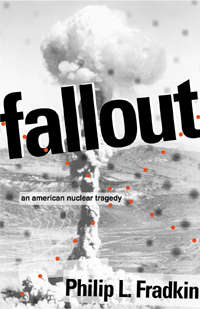 W
WFallout: An American Nuclear Tragedy is a 1989 book by Philip L. Fradkin which was republished in a second edition in 2004. The book is about the radiation exposure of people and their livestock living downwind from the nuclear weapons testing at the Nevada Test Site in the 1950s. The case of Irene Allen et al. vs. the United States is used as a framework for the narrative. The court case "resulted in an award of $2.66 million in damages to eight persons with leukemia, one with thyroid cancer, and another with breast cancer".
 W
WThe Fate of the Earth is a 1982 book by Jonathan Schell. This "seminal" description of the consequences of nuclear war "forces even the most reluctant person to confront the unthinkable: the destruction of humanity and possibly most life on Earth". The book is regarded as a key document in the nuclear disarmament movement.
 W
WThe Four Faces of Nuclear Terrorism is a 2004 book by Charles D. Ferguson and William C. Potter which explores the motivations and capabilities of terrorist organizations to carry out significant attacks using stolen nuclear weapons, to construct and detonate crude nuclear weapons, to release radiation by attacking or sabotaging nuclear facilities, and to build and use radiological weapons or "dirty bombs." The authors argue that these "four faces" of nuclear terrorism are real threats which U.S. policy has failed to take into account. The book is the result of a two-year study by the Monterey Institute's Center for Nonproliferation Studies.
 W
WThe Gift of Time: The Case for Abolishing Nuclear Weapons Now is a 1998 book by Jonathan Schell. The book is based on interviews with individuals who had responsibility for nuclear weapons policy in the United States, Russia and Europe, and who came to advocate the global elimination of nuclear weapons. Schell addresses the key issues of nuclear deterrence, disarmament, abolition, and breakout associated with nuclear weapons policy.
 W
WHow to Photograph an Atomic Bomb is a history and photography book written by Peter Kuran and published in 2006 by VCE.
 W
WIn Mortal Hands: A Cautionary History of the Nuclear Age is a 2009 book by Stephanie Cooke. The book explains why nuclear energy failed to develop in the way its planners hoped, and explores the relationship between the military and civilian sides of nuclear energy. In the book, Cooke argues that we are not close to solving the nuclear waste problem, and that "the billions spent by government on nuclear over the past sixty years crowded out other energy options". The book suggests that there are practical reasons why nuclear reactors are unlikely to provide a solution to the global climate change problem.
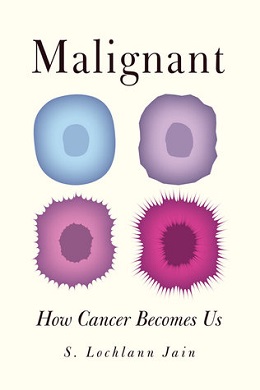 W
WMalignant: How Cancer Becomes Us is a 2013 book by S. Lochlann Jain, published by University of California Press. Jain writes about their experience with an advanced form of breast cancer at the age of 36.
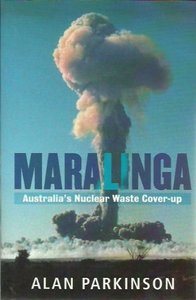 W
WMaralinga: Australia’s Nuclear Waste Cover-up is a book by Alan Parkinson about the clean-up of the British atomic bomb test site at Maralinga in South Australia, published in 2007. Parkinson, a nuclear engineer, explains that the clean-up of Maralinga in the late 1990s was compromised by cost-cutting and simply involved dumping hazardous radioactive debris in shallow holes in the ground. Parkinson states that "What was done at Maralinga was a cheap and nasty solution that wouldn't be adopted on white-fellas land."
 W
WMother Country: Britain, the Welfare State, and Nuclear Pollution (1989) is a work of nonfiction by Marilynne Robinson that tells the story of Sellafield, a government nuclear reprocessing plant located on the coast of the Irish Sea. The book shows how the closest village to Sellafield suffers from death and disease due to decades of waste and radiation from the plant. Mother Country was a National Book Award finalist for Nonfiction in 1989. While on sabbatical in England, Robinson's interest in the environmental ramifications of the plant began when she discovered a newspaper article detailing its hazards.
 W
WThe Navajo People and Uranium Mining (2006) is a non-fiction book edited by Doug Brugge, Timothy Benally, and Esther Yazzie-Lewis; it uses oral histories to tell the stories of Navajo Nation families and miners in the uranium mining industry. The foreword is written by Stewart L. Udall, former U.S. Secretary of the Interior.
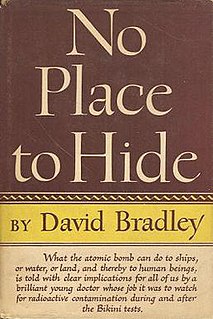 W
WNo Place to Hide is a 1948 book by American writer David J. Bradley published by Little, Brown and Company. The book is a Harvard Medical School graduate's autobiographical tale of his work in the Radiological Safety Section in the Pacific in the aftermath of the Bikini atomic bomb tests, Operation Crossroads. The book alerted the world to the dangers of radioactive fallout from nuclear weapon explosions. The book was marketed for Bantam by Judith Merril, who found Bradley's prose "a man's book with little appeal for women", leading her to later write her own nuclear war story Shadow on the Hearth from the homemaker's perspective. Bradley toured lecturing on the dangers of fallout, including a 1950 lecture at Ford Hall Forum.
 W
WNon-Nuclear Futures: The Case for an Ethical Energy Strategy is a 1975 book by Amory B. Lovins and John H. Price. The main theme of the book is that the most important parts of the nuclear power debate are not technical disputes but relate to personal values, and are the legitimate province of every citizen, whether technically trained or not. Lovins and Price suggest that the personal values that make a high-energy society work are all too apparent, and that the values associated with an alternate view relate to thrift, simplicity, diversity, neighbourliness, craftsmanship, and humility. They also argue that large nuclear generators could not be mass-produced. Their centralization requires costly transmission and distribution systems. They are inefficient, not recycling excess thermal energy. The authors believed that nuclear reactors were less reliable and take longer to build, exposing them to escalated interest costs, mistimed demand forecasts, and wage pressure by unions.
 W
WNormal Accidents: Living with High-Risk Technologies is a 1984 book by Yale sociologist Charles Perrow, which provides a detailed analysis of complex systems from a sociological perspective. It was the first to "propose a framework for characterizing complex technological systems such as air traffic, marine traffic, chemical plants, dams, and especially nuclear power plants according to their riskiness". Perrow argues that multiple and unexpected failures are built into society's complex and tightly coupled systems. Such accidents are unavoidable and cannot be designed around.
 W
WNuclear Implosions: The Rise and Fall of the Washington Public Power Supply System is a 2008 book by Daniel Pope, a history professor at the University of Oregon, which traces the history of the Washington Public Power Supply System, a public agency which undertook to build five large nuclear power plants, one of the most ambitious U.S. construction projects in the 1970s.
 W
WNuclear Nebraska: The Remarkable Story of the Little County That Couldn’t Be Bought is a 2007 book by Susan Cragin which follows the controversy about a proposed low level nuclear waste dump, which was planned for Boyd County, Nebraska.
 W
WNuclear Terrorism: The Ultimate Preventable Catastrophe is a 2004 book by Harvard scholar Graham Allison. Allison explains that terrorists have been striving to acquire and then use nuclear weapons against the United States. During the 2004 U.S. Presidential election, President George W. Bush and Senator John Kerry featured the issue of terrorism in their foreign policy platforms, and both said it is the nation's foremost security challenge. Nuclear Terrorism is described as a well-written report for general readers on the terrorist threat and what is needed to reduce it.
 W
WNuclear War Survival Skills or NWSS, by Cresson Kearny, is a civil defense manual. It contains information gleaned from research performed at Oak Ridge National Laboratory during the Cold War, as well as from Kearny's extensive jungle living and international travels.
 W
WNukespeak: Nuclear Language, Visions and Mindset is a 1982 book by Stephen Hilgartner, Richard C. Bell and Rory O'Connor. This book is a concise history of nuclear weapons and nuclear power in the United States, with special emphasis on the language of the "nuclear mindset".
 W
WIn his 2007 book On Nuclear Terrorism, author Michael A. Levi surveys the issue of nuclear terrorism and explores the decisions a terrorist leader might take in pursuing a nuclear plot. Levi points out the many obstacles that such a terrorist scheme may encounter, which in turn leads to a host of possible ways that any terrorist plan could be foiled.
 W
WThe Plutonium Files: America's Secret Medical Experiments in the Cold War is a 1999 book by Eileen Welsome. It is a history of United States government-engineered radiation experiments on unwitting Americans, based on the Pulitzer Prize–winning series Welsome wrote for The Albuquerque Tribune.
 W
WPower to Save the World: The Truth About Nuclear Energy, by Gwyneth Cravens, is an introduction to the benefits of nuclear power and the science behind it. It is written for members of the lay public who want to learn more about nuclear power, environmentalists concerned about global warming due to fossil fuel combustion; and scientists and others who work in the nuclear world.
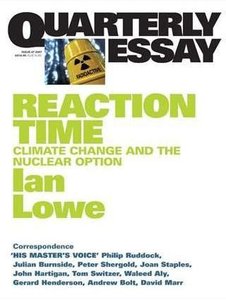 W
WReaction Time: Climate Change and the Nuclear Option is a book by Professor Ian Lowe which was officially launched by science broadcaster Robyn Williams at the Writers' Festival in Brisbane in September 2007. The book is about energy policy, and Lowe argues that nuclear power does not make sense on any level: economically, environmentally, politically or socially.
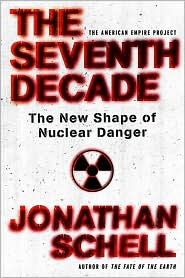 W
WThe Seventh Decade: The New Shape of Nuclear Danger is a 2007 book by Jonathan Schell. It is described as a provocative book which explores the threat posed by some new nuclear policies of the United States.
 W
WStrong in the Rain: Surviving Japan's Earthquake, Tsunami, and Fukushima Nuclear Disaster is a book by Lucy Birmingham and David McNeill published in 2012. The title is taken from the Japanese poem by Kenji Miyazawa about endurance.
 W
WSurvival Under Atomic Attack was the title of an official United States government booklet released by the Executive Office of the President, the National Security Resources Board, and the Civil Defense Office. Released at the onset of the Cold War era, the pamphlet was in line with rising fears that the Soviet Union would launch a nuclear attack against the United States, and outlined what to do in the event of an atomic attack.
 W
WTotem and Ore is a collection of 5 000 photographs taken by B Wongar in 1960s and early 1970s. The photographs were taken in northern and central Australia. The collection is about tragedy of Australian Aborigines - the people who lived through dual tragedy, the mining of uranium and the subsequent British nuclear testing in that area. To deflect any criticism of the testing Australian government enacted Australian Atomic Energy Act forbiding publishing any kind of information about it. The penalty for violating the Act was imprisonment up to 20 years. The uranium mining and nuclear testing destroyed Australian Aborigines natural habitat and decimated their population in northern and central Australia.
 W
WIn the 2001 book The Unfinished Twentieth Century, author Jonathan Schell suggests that an essential feature of the twentieth century was the development of humankind's capacity for self-destruction, with the rise in many forms of "policies of extermination". Schell goes on to suggest that the world now faces a clear choice between the abolition of all nuclear weapons, and full nuclearization, as the necessary technology and materials diffuse around the globe.
 W
WWhen Technology Fails, edited by Neil Schlager, is a collection of 103 case studies about significant technological disasters, accidents, and failures of the 20th century. It was published in 1994 by Gale Research, Inc. It was one of the top referenced books in the New York Public Library in 1995. The book was updated and re-released in 2005.
 W
WThe World Nuclear Industry Status Report is a yearly report on the nuclear power industry. It is produced by Mycle Schneider, a founding member of WISE-Paris, which is the French branch of the anti-nuclear group WISE, which he directed from 1983 to 2003.